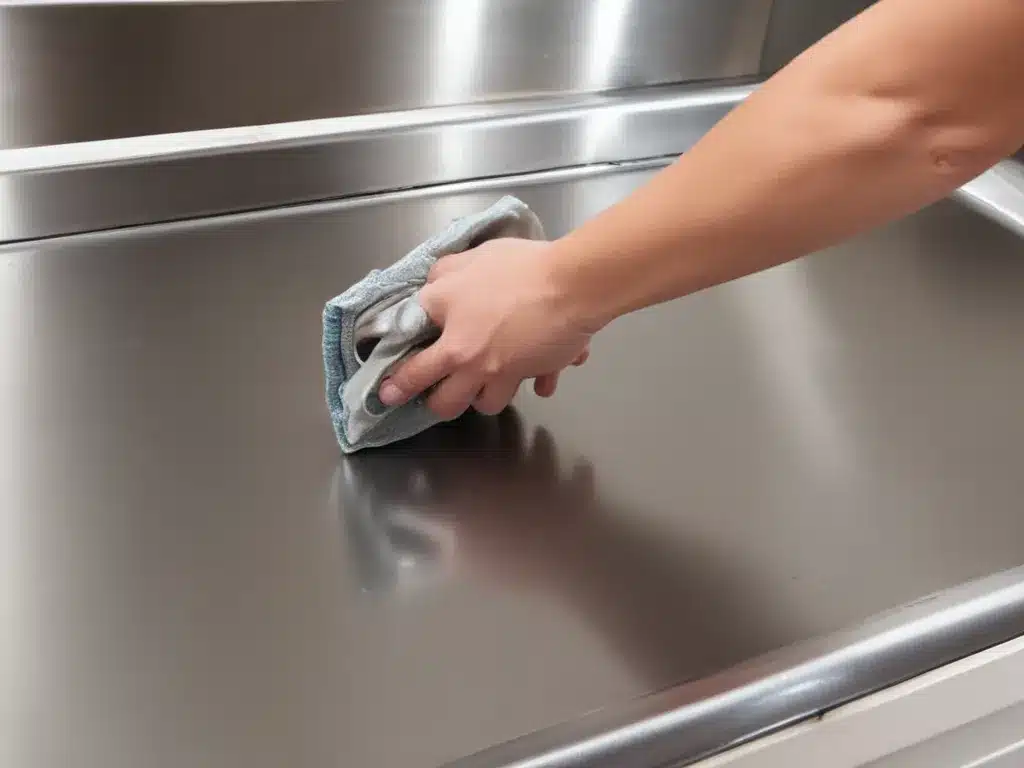Introduction
Keeping stainless steel surfaces clean and shiny can be a daunting task, especially when using commercial cleaners that may contain harsh chemicals. However, there’s a simple and cost-effective solution: creating your own DIY stainless steel cleaner and polish. Not only is it more eco-friendly, but it also allows you to control the ingredients, ensuring a safe and effective cleaning experience.
In this comprehensive guide, I’ll walk you through the process of making your own DIY stainless steel cleaner and polish, covering everything from the necessary ingredients to the application techniques. Whether you’re maintaining your kitchen appliances, outdoor grills, or any other stainless steel surfaces, this DIY solution will leave them sparkling and protected.
Ingredients and Supplies
Before we dive into the recipe, let’s gather the necessary ingredients and supplies:
- Olive oil or mineral oil
- White vinegar
- Essential oils (optional, for a pleasant scent)
- Clean microfiber cloths or soft rags
- Spray bottle (for the cleaning solution)
- Small container (for the polishing oil)
Olive Oil or Mineral Oil
Olive oil or mineral oil serves as the base for our DIY polish. These oils help to nourish and protect the stainless steel surface, leaving it with a glossy sheen. Opt for extra virgin olive oil or food-grade mineral oil for the best results.
White Vinegar
White vinegar is a powerful natural cleaner that cuts through grease, grime, and stubborn stains. Its acidic properties make it an excellent choice for removing water spots, fingerprints, and other marks from stainless steel surfaces.
Essential Oils (Optional)
If you prefer a pleasant scent, you can add a few drops of your favorite essential oils to the cleaner or polish. Popular choices include lemon, orange, or lavender, but feel free to experiment with different aromas.
Microfiber Cloths or Soft Rags
Microfiber cloths or soft, lint-free rags are essential for applying the cleaner and polish effectively. These materials won’t scratch or damage the stainless steel surface and are gentle yet efficient in cleaning and polishing.
Spray Bottle and Small Container
You’ll need a spray bottle to store and apply the cleaning solution, and a small container (such as a jar or a squeeze bottle) to hold the polishing oil.
The Recipe
Step 1: Make the Stainless Steel Cleaner
- Fill a spray bottle with equal parts white vinegar and water. For example, if you’re using a 16-ounce spray bottle, add 8 ounces of white vinegar and 8 ounces of water.
- If desired, add a few drops of your favorite essential oil to the mixture.
- Shake the bottle gently to combine the ingredients.
Step 2: Create the Stainless Steel Polish
- Pour olive oil or mineral oil into a small container, leaving enough room for easy application.
- If desired, add a few drops of essential oil to the polish for a pleasant scent.
- Close the container and give it a gentle shake to blend the oils.
Application Process
Step 1: Clean the Surface
- Start by spraying the stainless steel surface with the DIY cleaner.
- Use a microfiber cloth or soft rag to wipe down the surface, following the direction of the grain (if applicable).
- Pay special attention to any stubborn stains or built-up grime, applying a little extra elbow grease if needed.
Step 2: Polish the Surface
- Once the surface is clean, apply a small amount of the DIY polish to a clean microfiber cloth or soft rag.
- Rub the polish onto the stainless steel surface in a circular motion, following the direction of the grain (if applicable).
- Apply light pressure and work in small sections until the entire surface is polished.
Step 3: Buff and Shine
- After polishing the entire surface, use a clean, dry microfiber cloth or soft rag to buff the stainless steel.
- Apply firm pressure and rub in a circular motion to bring out the shine and remove any excess polish.
- Admire the gleaming, streak-free finish!
Tips and Tricks
- Always clean and polish in the direction of the grain for the best results and to avoid unsightly scratches.
- Use separate microfiber cloths or rags for cleaning and polishing to prevent cross-contamination and ensure maximum effectiveness.
- For tough, baked-on stains or rust spots, make a paste with baking soda and water, and gently scrub the affected area before applying the DIY cleaner.
- Regularly maintain your stainless steel surfaces by using the DIY cleaner and polish every few weeks or as needed.
Conclusion
Creating your own DIY stainless steel cleaner and polish is not only cost-effective but also eco-friendly and allows you to control the ingredients used. By following this comprehensive guide, you’ll be able to keep your stainless steel surfaces looking pristine and protected without the need for harsh chemicals. Embrace the satisfaction of a sparkling, streak-free finish achieved through your own DIY efforts. Happy cleaning and polishing!
For professional cleaning services and top-notch results, visit AdamCleaning.uk.







